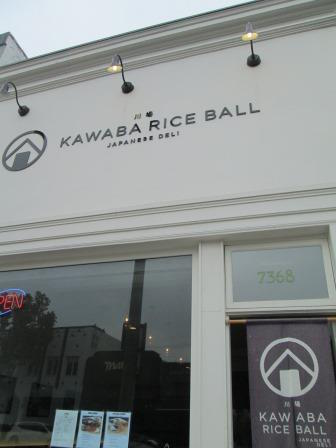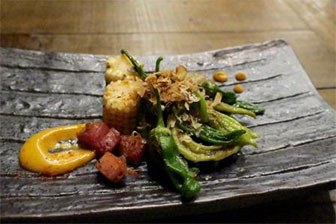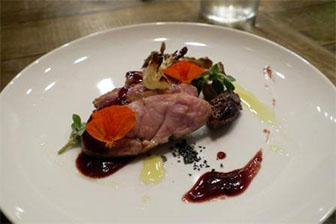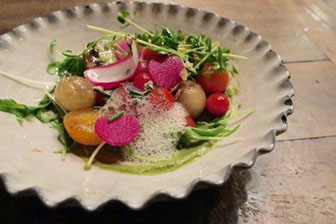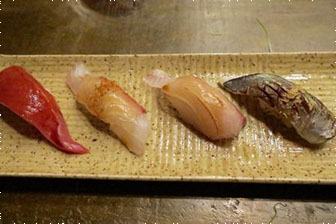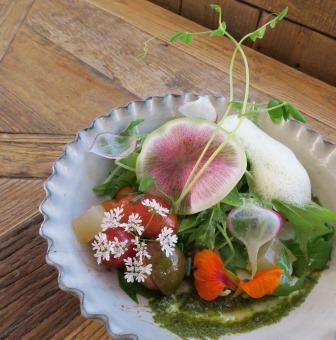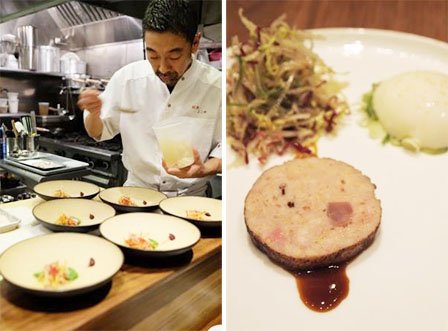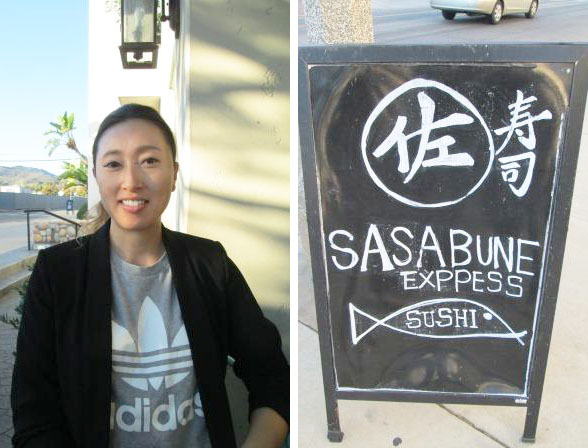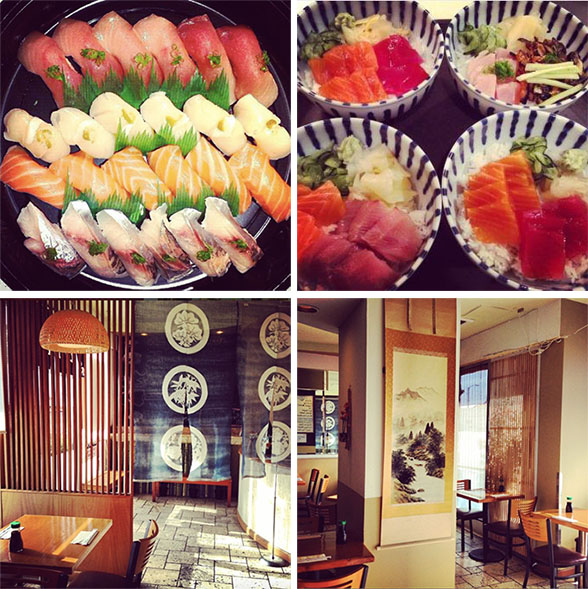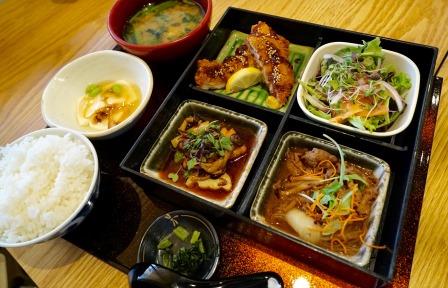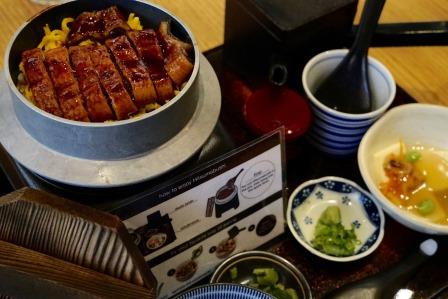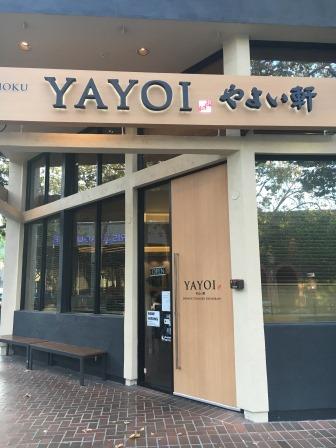Counter only small diner to enjoy creative Japanese cuisine, sake, and wine
By Aya Ota
Brick walls, spacious wooden counter, tastefully decorated interior, and beautiful tableware---It is a space which looks like an art gallery, but actually a restaurant that magically makes you feel welcomed. The restaurant is “Rabbit House”, where you can enjoy creative Japanese style tapas dishes with sake and wine in a casual ambience. It is located in the middle point between the Lower East Side and China Town, where some changes have been seen lately with new comers of galleries and general stores, but still mainly occupied by Chinese restaurants and general stores. It is rather surprising to see such a sophisticated looking space hidden in such an area.
“I like to cook, but I like to eat even more. I also like to drink sake and wine. Nothing pleases me more than hearing people enjoy my cooking, and sake that I eagerly selected myself”, says Yoshiko Sakuma, the owner and chef. Rabbit House opened in March of 2016 to realize her extremely simple passion. Her grandparents were farmers, and her parents were both cooks. She developed the delicate sense of tastes in growing up surrounded by fresh and high-quality food ingredients. It must have been natural for her to grow up to be in the cooking world. She came to the United States 20 years ago, and built up experiences working in notable restaurants and bakeries, and in 2010, went to Italy and Spain to show off her skills in various restaurants.
As implied in her quote, “I want to offer our customers something that leaves an impression which nowhere else can,” the dishes Ms. Sakuma creates are full of originality and playfulness, which you don’t see anywhere else. The “Oyster Shot” in the Tasting Course offered as an amusement, is an oyster dish with dessert wine jelly and beer poured over it. You indulge yourself in tasting the superb harmony of freshness, sweetness, and slight bitterness while admiring the beautiful presentation. The “Addicted Spare Rib” has a volume that exceeds the category of an appetizer. It is a unique dish marinated in sake and soy sauce overnight, and flavored with curry spice. As the name indicates, the taste is addictive, and the regulars order this dish all the time. The “Trapped Rabbit” is a dish of extracted umami. Shiitake mushrooms and baby carrots are rolled up with rabbit meat caul fat. Every dish gives you a surprise and an impression when delivered in front of you, and again when you taste it. The carefully selected line of alcoholic beverages is also unique by her extensive knowledge in sake as a sake sommelier, and wine knowledge she acquired in Spain and Italy, which you do not see anywhere else. You cannot help keep pairing with every dish you taste.
The name, Rabbit House, literally means a house for rabbits, and is an expression to deprecatingly indicate how small Japanese houses are. The eating space has only 9 counter seats, and basically only one person handles everything from cooking to serving. All the menu items--appetizers, main dishes, desserts, and cocktails, are created by her. The ingredients don’t come from any particular place, but are carefully selected based on the taste. Especially the quality of selected meat is at a fine dining level. Although the menu items have been narrowed down, this one person makes everything with a lot of care without skipping any necessary steps in this limited kitchen space. She also accommodates for vegan and gluten-free requests.
“Every day is a process of trial and error. I am good at creating, but not at selling,” says Ms. Sakuma. She said that it was difficult to attract customers to the restaurant because of the location that has not much traffic. She used the “Groupon” vouchers for advertisement, but it worked negatively for the image of the restaurant, and resulted in bad reviews. She turned all those mistakes around, and changed them to positive power, pursued what should be done in this limited space and man-power, and kept trying to make improvements. She reached a conclusion, which was, “to tell customers what I can do, and what I cannot do clearly. Customers’ satisfaction relies heavily on good communication.” This straight-forwardness and honesty of Ms. Sakuma must be one of the appeals of this restaurant. Now, supported by the regular customers, they get reviewed highly on the internet, and has become able to attract customers by word of mouth.
Actually, there used to be 6 tables in addition to the existing 9 counter seats before, but it was changed not long ago to the present operation style. She would like to take in the “Chef’s Tasting Table” concept, and have customers enjoy conversations while enjoying the tastes of food and wine. I truly look forward to the future development of this restaurant.
和風創作料理と日本酒・ワインをカウンター席で楽しむ小料理屋
煉瓦造りの壁、広々とした木製カウンター、センスのよい調度品や食器類……まるでギャラリーのような空間だが、不思議に居心地のよい店がある。ここ『Rabbit House』では、創意工夫に富んだ和風タパスと一緒に日本酒やワインをカジュアルに楽しめる。場所はロウワーイーストサイドとチャイナタウンの中間地点。最近でこそギャラリーや雑貨店なども新しく登場し変化を遂げつつあるが、まだまだ中国系飲食店や雑貨店が多く建ち並ぶこの地域に、「まさか、こんな洒落た店がひっそりと隠れているなんて」と驚かされる。
「作るのも好きだが食べるのはもっと好き。お酒やワインも好き。自分が作った料理を喜んでもらえて、自分がこだわって選んだお酒を美味しいと言ってもらえるのが、何よりうれしい」――オーナーシェフを務める佐久間良子氏の至極シンプルな情熱を形にして、2016年3月に誕生したのが、この『Rabbit House』だ。佐久間氏は、祖父母は農家、両親は料理人という家系で生まれ育ち、新鮮で高品質な素材に囲まれ、繊細な味覚を養ってきた。同氏が料理の道に進んだのはごく自然な流れだったのだろう。約20年前に渡米後は、ニューヨークの蒼々たるレストランやベーカリーで経験を積み、2010年にはイタリアとスペインに渡り、数々の店で腕を奮ってきた。
「世の中に数多くの店がある中で、うちに来てくれた客には、印象に残る何かを提供したい」と語る佐久間氏が創り出す料理は、他店にはない独創性と遊び心にあふれている。テイスティングコースを注文するとアミューズとして登場する「Oyster Shot」は、牡蠣にデザートワインで作ったゼリーとビールを注いだ一品。美しい盛り付けに目を奪われながら、爽やかさと甘さとほろ苦さの絶妙な調和を堪能する。「Addicted Spare Rib」は、とても前菜とは思えないボリューム。日本酒と醤油で一晩漬け込み、カレースパイスで風味付けした独創的な一品。名前の通り病みつきになる味で、常連客も毎回注文するほどだ。「Trapped Rabbit」は、椎茸やベイビーキャロットをウサギ肉と網脂で巻き込み、うま味を凝縮した一品。どの料理も、目の前に出される度に、そして料理を口に運ぶ度に、感動と驚きがある。酒ソムリエとしての日本酒知識と、スペイン・イタリア滞在で身につけたワインの知識をフルに活かして厳選した酒類ラインナップも個性的で、他店にはない品揃えだ。思わず料理とのペアリングも進んでしまう。
店名の『Rabbit House』は文字通り「ウサギ小屋」という意味で、日本人の住居が狭いことを自嘲気味に表現するときに使われる言葉だ。店内は、カウンター9席のみで、基本的に一人で料理から接客まで対応する。前菜、メイン、デザートやカクテルに至るまで、すべて自ら考案したものだ。原料は産地にこだわらず、美味しいと思う原料を厳選、特に肉はファインダイニングと同品質のものを使っている。メニュー数は絞り込んでいるものの、限られたスペースの厨房で、たった一人で、一切の手抜きなしで丁寧に作り込む。さらにヴィーガンやグルテンフリーにも対応している。
「毎日が試行錯誤。作るのは得意だが売るのは得意ではない」と佐久間氏は話す。決して人通りが多いとは言えない立地で、集客に苦労してきたという。以前、『グルーポン』などのバウチャーサービスを使って宣伝したが、店のイメージに誤解が生じ、悪評を書かれてしまったこともあったという。しかし、それらを全てプラスの原動力に変え「この限られた空間と人材で何ができるのか、何をしなくてはいけないのか」と追及し、改善に努めてきた。そして、行き着いた結論は「客に対して、できること・できないことをしっかり伝える。しっかりコミュニケーションを図ることで客の満足度は大きく異なる」ということだった。この正直さ、率直さが佐久間氏自身と店の魅力でもあるのだろう。今では、多くの常連客に支持され、ネットでも高評価を得るようになり、口コミで集客できるようになったという。
実は、かつてはカウンター9席に加え、テーブル6席もあったが、カウンター中心の運営にしたのはごく最近のことだ。今後は「Chef’s Tasting Table」のコンセプトも取り入れ、客と対話しながら、料理や酒を味わってもらいたいと考えている。今後の展開がますます楽しみな店だ。
Rabbit House
76 Forsyth Street
New York, NY 10002
Tel: 212-343-4200
http://www.rabbithouse.nyc/
Dinner
Tue - Thu & Sun 5:00 - 11:00 pm
Fri & Sat 5:00 pm - 0:00 am
Brunch
Sat & Sun 12 - 4:00 pm
Mon: Closed
Brick walls, spacious wooden counter, tastefully decorated interior, and beautiful tableware---It is a space which looks like an art gallery, but actually a restaurant that magically makes you feel welcomed. The restaurant is “Rabbit House”, where you can enjoy creative Japanese style tapas dishes with sake and wine in a casual ambience. It is located in the middle point between the Lower East Side and China Town, where some changes have been seen lately with new comers of galleries and general stores, but still mainly occupied by Chinese restaurants and general stores. It is rather surprising to see such a sophisticated looking space hidden in such an area.
“I like to cook, but I like to eat even more. I also like to drink sake and wine. Nothing pleases me more than hearing people enjoy my cooking, and sake that I eagerly selected myself”, says Yoshiko Sakuma, the owner and chef. Rabbit House opened in March of 2016 to realize her extremely simple passion. Her grandparents were farmers, and her parents were both cooks. She developed the delicate sense of tastes in growing up surrounded by fresh and high-quality food ingredients. It must have been natural for her to grow up to be in the cooking world. She came to the United States 20 years ago, and built up experiences working in notable restaurants and bakeries, and in 2010, went to Italy and Spain to show off her skills in various restaurants.
As implied in her quote, “I want to offer our customers something that leaves an impression which nowhere else can,” the dishes Ms. Sakuma creates are full of originality and playfulness, which you don’t see anywhere else. The “Oyster Shot” in the Tasting Course offered as an amusement, is an oyster dish with dessert wine jelly and beer poured over it. You indulge yourself in tasting the superb harmony of freshness, sweetness, and slight bitterness while admiring the beautiful presentation. The “Addicted Spare Rib” has a volume that exceeds the category of an appetizer. It is a unique dish marinated in sake and soy sauce overnight, and flavored with curry spice. As the name indicates, the taste is addictive, and the regulars order this dish all the time. The “Trapped Rabbit” is a dish of extracted umami. Shiitake mushrooms and baby carrots are rolled up with rabbit meat caul fat. Every dish gives you a surprise and an impression when delivered in front of you, and again when you taste it. The carefully selected line of alcoholic beverages is also unique by her extensive knowledge in sake as a sake sommelier, and wine knowledge she acquired in Spain and Italy, which you do not see anywhere else. You cannot help keep pairing with every dish you taste.
The name, Rabbit House, literally means a house for rabbits, and is an expression to deprecatingly indicate how small Japanese houses are. The eating space has only 9 counter seats, and basically only one person handles everything from cooking to serving. All the menu items--appetizers, main dishes, desserts, and cocktails, are created by her. The ingredients don’t come from any particular place, but are carefully selected based on the taste. Especially the quality of selected meat is at a fine dining level. Although the menu items have been narrowed down, this one person makes everything with a lot of care without skipping any necessary steps in this limited kitchen space. She also accommodates for vegan and gluten-free requests.
“Every day is a process of trial and error. I am good at creating, but not at selling,” says Ms. Sakuma. She said that it was difficult to attract customers to the restaurant because of the location that has not much traffic. She used the “Groupon” vouchers for advertisement, but it worked negatively for the image of the restaurant, and resulted in bad reviews. She turned all those mistakes around, and changed them to positive power, pursued what should be done in this limited space and man-power, and kept trying to make improvements. She reached a conclusion, which was, “to tell customers what I can do, and what I cannot do clearly. Customers’ satisfaction relies heavily on good communication.” This straight-forwardness and honesty of Ms. Sakuma must be one of the appeals of this restaurant. Now, supported by the regular customers, they get reviewed highly on the internet, and has become able to attract customers by word of mouth.
Actually, there used to be 6 tables in addition to the existing 9 counter seats before, but it was changed not long ago to the present operation style. She would like to take in the “Chef’s Tasting Table” concept, and have customers enjoy conversations while enjoying the tastes of food and wine. I truly look forward to the future development of this restaurant.
和風創作料理と日本酒・ワインをカウンター席で楽しむ小料理屋
煉瓦造りの壁、広々とした木製カウンター、センスのよい調度品や食器類……まるでギャラリーのような空間だが、不思議に居心地のよい店がある。ここ『Rabbit House』では、創意工夫に富んだ和風タパスと一緒に日本酒やワインをカジュアルに楽しめる。場所はロウワーイーストサイドとチャイナタウンの中間地点。最近でこそギャラリーや雑貨店なども新しく登場し変化を遂げつつあるが、まだまだ中国系飲食店や雑貨店が多く建ち並ぶこの地域に、「まさか、こんな洒落た店がひっそりと隠れているなんて」と驚かされる。
「作るのも好きだが食べるのはもっと好き。お酒やワインも好き。自分が作った料理を喜んでもらえて、自分がこだわって選んだお酒を美味しいと言ってもらえるのが、何よりうれしい」――オーナーシェフを務める佐久間良子氏の至極シンプルな情熱を形にして、2016年3月に誕生したのが、この『Rabbit House』だ。佐久間氏は、祖父母は農家、両親は料理人という家系で生まれ育ち、新鮮で高品質な素材に囲まれ、繊細な味覚を養ってきた。同氏が料理の道に進んだのはごく自然な流れだったのだろう。約20年前に渡米後は、ニューヨークの蒼々たるレストランやベーカリーで経験を積み、2010年にはイタリアとスペインに渡り、数々の店で腕を奮ってきた。
「世の中に数多くの店がある中で、うちに来てくれた客には、印象に残る何かを提供したい」と語る佐久間氏が創り出す料理は、他店にはない独創性と遊び心にあふれている。テイスティングコースを注文するとアミューズとして登場する「Oyster Shot」は、牡蠣にデザートワインで作ったゼリーとビールを注いだ一品。美しい盛り付けに目を奪われながら、爽やかさと甘さとほろ苦さの絶妙な調和を堪能する。「Addicted Spare Rib」は、とても前菜とは思えないボリューム。日本酒と醤油で一晩漬け込み、カレースパイスで風味付けした独創的な一品。名前の通り病みつきになる味で、常連客も毎回注文するほどだ。「Trapped Rabbit」は、椎茸やベイビーキャロットをウサギ肉と網脂で巻き込み、うま味を凝縮した一品。どの料理も、目の前に出される度に、そして料理を口に運ぶ度に、感動と驚きがある。酒ソムリエとしての日本酒知識と、スペイン・イタリア滞在で身につけたワインの知識をフルに活かして厳選した酒類ラインナップも個性的で、他店にはない品揃えだ。思わず料理とのペアリングも進んでしまう。
店名の『Rabbit House』は文字通り「ウサギ小屋」という意味で、日本人の住居が狭いことを自嘲気味に表現するときに使われる言葉だ。店内は、カウンター9席のみで、基本的に一人で料理から接客まで対応する。前菜、メイン、デザートやカクテルに至るまで、すべて自ら考案したものだ。原料は産地にこだわらず、美味しいと思う原料を厳選、特に肉はファインダイニングと同品質のものを使っている。メニュー数は絞り込んでいるものの、限られたスペースの厨房で、たった一人で、一切の手抜きなしで丁寧に作り込む。さらにヴィーガンやグルテンフリーにも対応している。
「毎日が試行錯誤。作るのは得意だが売るのは得意ではない」と佐久間氏は話す。決して人通りが多いとは言えない立地で、集客に苦労してきたという。以前、『グルーポン』などのバウチャーサービスを使って宣伝したが、店のイメージに誤解が生じ、悪評を書かれてしまったこともあったという。しかし、それらを全てプラスの原動力に変え「この限られた空間と人材で何ができるのか、何をしなくてはいけないのか」と追及し、改善に努めてきた。そして、行き着いた結論は「客に対して、できること・できないことをしっかり伝える。しっかりコミュニケーションを図ることで客の満足度は大きく異なる」ということだった。この正直さ、率直さが佐久間氏自身と店の魅力でもあるのだろう。今では、多くの常連客に支持され、ネットでも高評価を得るようになり、口コミで集客できるようになったという。
実は、かつてはカウンター9席に加え、テーブル6席もあったが、カウンター中心の運営にしたのはごく最近のことだ。今後は「Chef’s Tasting Table」のコンセプトも取り入れ、客と対話しながら、料理や酒を味わってもらいたいと考えている。今後の展開がますます楽しみな店だ。
Rabbit House
76 Forsyth Street
New York, NY 10002
Tel: 212-343-4200
http://www.rabbithouse.nyc/
Dinner
Tue - Thu & Sun 5:00 - 11:00 pm
Fri & Sat 5:00 pm - 0:00 am
Brunch
Sat & Sun 12 - 4:00 pm
Mon: Closed







